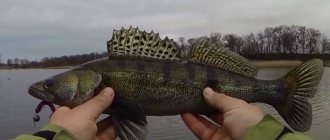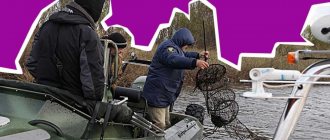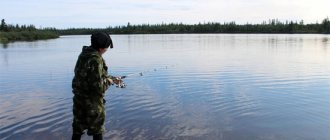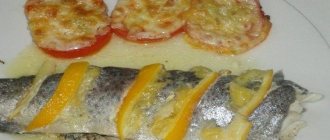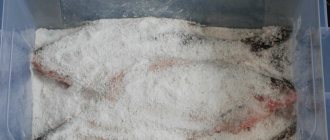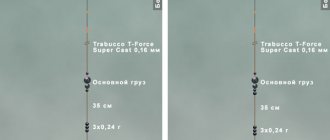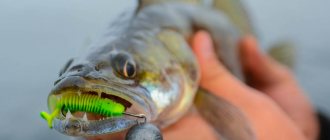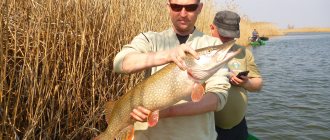Ways to catch pike perch
There are several most popular ways to catch pike perch in October:
- Fishing with spinners
- Jig fishing
- Trolling
- Plumb fishing from a boat
- Bottom fishing with live bait
Catching pike perch with spinners - this method has been known since Soviet times. Such lures for pike perch are quite easy to use, do not require much skill from the angler, and do not place any special demands on the shape of the rod or reel. However, given the weight of the spinners most often used for catching pike perch, it is worth classifying such fishing as light and ultralight fishing. In addition, they will sink into the bottom layer at great depths for too long, and the accuracy of the postings will be lost. Still, spinners work better at shallow depths and catch pike perch in the summer at night.
Fishing with spinners and wobblers
The technique of fishing with spoons and wobblers varies depending on the specific bait. Understanding the game of each of them means success in catching fish. But in any case, wiring will be carried out at a depth where twitching is unproductive. Here it is best to fish with classic fishing lines:
- uniform;
- stop and go;
- step with different pauses;
- blasting the bait from the bottom with a rod or reel;
- a combination of the above.
Really catchy animation can be found in practical fishing, because fishing conditions and fish preferences are constantly changing, and the fisherman’s task is to adapt to them.
You can catch pike perch with wobblers using a Moscow rig or a retractable leash. In this case, the best result will be obtained by dragging with short pauses, during which the bait can float or sink depending on the degree of its buoyancy. Such animation can stir up even the most inactive predator.
The pike perch was caught on a long minnow-class wobbler.
Fishing with jig baits
According to the majority of practicing fishermen, catching pike perch in October with a jig is the most successful and efficient way of hunting a fanged predator. In this case, both simple combined installations and spaced equipment are used:
- drop shot - in a snag;
- Carolina and Texas - on an overgrown bottom;
- retractable leash - for guiding unloaded baits over a capricious predator.
Offset hooks or jig heads can be equipped with the following baits:
- vibrating tails;
- twisters;
- foam rubber;
- mandulas.
Our help! Foam rubber baits and mandules are easy to make with your own hands. Many zander fishermen make these baits even directly on the pond.
There is a mandula bait in the pike perch's mouth.
There is no need to waste time with the size of baits in the fall; silicone and foam rubber from 7 to 13 centimeters are considered the most effective. The sinker is selected depending on the bait, the test of the rod and the strength of the current in the pond. In any case, it should ensure control of the bait throughout the entire wiring.
Catching pike perch with a jig can be briefly described as follows:
- We cast in the chosen direction.
- We wait for the sinker to contact the bottom.
- We immediately pick up the slack.
- We lightly detonate the bait with the tip of the rod.
- We make two or three turns of the coil.
- We pause until the bait touches the bottom.
Continuing the wiring, we alternate the number of revolutions and the duration of pauses. In the end, the pike perch will be tempted by one of the proposed animations, provided, of course, that the school is located in the selected segment of the reservoir.
Jig fishing
The most popular way of catching autumn pike perch among spinning anglers. It is used throughout the fall - in September, October and November. They practice fishing with silicone fry, brooms, silicone crayfish, mandula, and jig spinners. They fish with a classic jig loaded with a Cheburashka and with a drop-shot rig, which helps fish the pike perch holes centimeter by centimeter, finding a passive pike perch and forcing it to bite. Heads are used relatively rarely, since they involve more uniform wiring in the water column, and not playing with a knock on the bottom.
TOP 5 baits in autumn
The best fall walleye lures to have on your boat when chasing fangs.
Mandulas from Siberian have especially proven themselves in cold autumn water. In sizes 100 - 120 mm, you should have different colors: the most common are black and yellow (“beeline”), variations of purple and red, black and orange, the colors of the Russian flag. In general, contrasting colors. Which one the pike perch will like that day should be selected on the spot.
The wiring of the mandula can be from a standard step to tossing or simply dragging along the very bottom. When paused, the bait stands vertically in the water column, allowing the pike perch to attack without any problems. Mandula is a must-have bait in the autumn set. The only thing is that you should only try it on in clean, non-contaminated places.
Where there are stumps from the old forest at the bottom, the mandula is powerless. Here a foam fish with a pressed double comes to the rescue. There is an opinion that foam rubber is generally the most stable and catchable autumn bait. Athletes cannot imagine any competition without it, especially when the conversation is about catching autumn pike perch. A size from 100 to 140 mm will fit perfectly into the autumn appetite of a predator. Dark colors are considered catchy - from black, dark blue, green, to red and burgundy. It’s good if the bait combines several colors. Dark back and brighter belly. Leader has a large selection of such foam rubber at reasonable prices.
Sawamura One'Up Shad
One of the best silicone baits in sizes 4 - 6 inches for catching pike perch. This is a very soft silicone. That is why it has an advantage in cold water. It plays well with its tail even on the slightest movements of the bait. It’s difficult to understand why the pike perch is in love with Sawamura, but it’s true.
Relax Copyto
The sweeping, powerful vibrations of its heel certainly attract a predator, which is guided by the lateral line organs and pronounced underwater vibrations. There’s not much to add here – one of the most popular silicone baits.
Fox Rage - Zander Pro Shad
The name speaks for itself. This is the option when you are hoping to catch a trophy. Combined colors of natural tones are a priority in the fall, but sometimes at certain times the color “Fire Tiger” is beyond competition.
There are very few nice days left on the calendar this season. There is no need to waste time, it’s time to arm yourself and go for an unforgettable catch. We hope that our tips will bring success in catching autumn pike perch, and that the last fishing trips of the outgoing season will be remembered for a long time.
Fishing with a retractable leash
Fishing with a retractable leash is not used so often. This method is more suitable for catching perch. Those who want to have a small but stable catch in the autumn should try this type of fishing. In autumn, perch smothers fry in the coastal zone. You can catch some pretty good bast fish using a jig rig with a retractable leader. This will be great practice for a beginner who is taking his first steps in jig fishing. Microjig fishing for pike perch is practically not used. For microjig, lightweight baits are used that work in the water column, and it is better to catch pike perch with a jig running in steps along the bottom.
The following can be said about jig baits and their wiring. All lures are divided into two types - those that have their own game on a uniform retrieve, such as twisters and vibrotails, and those that have no or almost no such game, such as foam rubber, worms, octopuses. For the latter, be sure to use edible silicone or flavor impregnation. They are more often grabbed by passive pike perch, and can easily be spit out if it senses a catch. It is also desirable that all baits have a fluorescent color and are clearly visible in the underwater autumn haze.
Trolling
Trolling is a fishing method that helps you quickly find active fish in a large area and provoke them to bite. It is very effective when searching for fish trails, as it allows you to find them in a short time over a large area. However, to successfully troll you need a good boat and a good motor. You need a four-stroke engine, which usually requires a permit, because fishing with a two-stroke under your ear all day can ultimately cause not pleasant fatigue, but a nervous breakdown.
They are caught by trolling with deep-sea wobblers. Be sure to use an echo sounder to timely track changes in the bottom, speed up or slow down the bait so that it runs approximately parallel to the bottom. A good echo sounder will show not only the fish and the bottom, but also the position of the wobbler if it is no more than 30 meters from the boat.
Fishing for pike perch in the fall is especially successful in October
Fishing for pike perch in the fall can begin in early September.
During this period, it is best to go fishing at night, when extraneous noises subside and you can enjoy the “quiet hunt.” Not everyone knows that catching pike perch in the fall is most effective using jigs. From September the fish move to their wintering grounds. Usually these are the deepest areas in the reservoir, so the use of jig baits is more important than ever.
With the onset of October, pike perch begins to show increased activity when searching for food. This is the longest meal, lasting almost a month. However, these days are quite enough for pike perch fishing in the fall to become the most catchy season. Avid fishermen consider October to be the luckiest month for catching large trophies.
Towards the end of November, the bite begins to gradually subside, however, even at this time you can catch quite large individuals. Most not very experienced fishermen, having had enough of the October “harvest”, tighten their fishing rods until spring, thereby missing out on the opportunity to catch a large pike perch. Depending on the weather, atmospheric pressure and the presence of wind, the fish goes out in search of food, sometimes approaching the very shore, where it becomes prey for the fisherman.
Catching pike perch in the fall on a donka involves the simultaneous use of several gears. For successful fishing, the rods are placed either all on one spot, or in pairs, making sure to maintain the angle between them in the casting direction for unhindered hooking and landing of pike perch.
At the same time, however, there is a high risk of overlapping or tangling of gear, so successful fishing for pike perch in the fall from the shore largely depends on the skill and experience of the fisherman.
The main thing is not to hook the bait. Therefore, many people prefer to fish with non-snagging rigs, regardless of how the fish is caught: from the shore or on the water.
The tackle should be sensitive not only to the catchable area, but also to the behavior of the bait when it comes into contact with the bottom. Pike perch most often bite in the fall, when there is a pause in reeling in the fishing line while directing the bait to the bottom. Sometimes he simply presses it, so it can be extremely difficult for the fisherman to catch the moment of the bite. However, most often such cases mean that it was a large fish that was caught on the hook. Therefore, at this moment you need to immediately carry out a powerful lightning-fast hook in order to have time to catch the fish’s mouth. If you delay, the bite may be missed.
Therefore, experienced fishermen, for whom fishing for pike perch in the fall is already familiar, consider the jig to be the most effective bait. The advantages of a jig spinning rod are the ability to “tap” the bottom to identify differences, depressions or hills, thanks to which fishing becomes not haphazard, but targeted.
In general, baits for autumn pike perch fishing are practically no different from summer ones, but there are still some fishing features. And the main ones are hydroacoustic vibrations, which are produced when moving bait in the water. In this case, hard river tires are most suitable.
Speed is also important for retrieving the bait. If the angler did not have time for the autumn meal, then the speed for the pike perch, which does not want to chase the bait, should be extremely low.
And yet, despite all the subtleties, autumn fishing for this fish has been and always remains a very exciting activity. It’s so nice to catch this not only beautiful, but also very tasty fish.
Plumb fishing
Plunge fishing will also require a boat. However, a powerful motor is not required in this case. For fishing, a side rod and a winter type balancer are used, but slightly larger and in a luminous color. When fishing, they try to determine the position of the fish using an echo sounder. Then, along the entire length of this flock, they follow, keeping the boat at a very low speed and correcting the course with the help of rare oar strokes, using a water parachute or an electric motor. When moving, they swing the rod, playing with the balancer and tempting the pike perch to take the bait. Even if the echo sounder shows not a pike perch, but a white fish, most likely a predator is following this school.
Fishing with live bait
Fishing with live bait in October is usually practiced by those who catch burbot. This can be fishing with a line, with a donk with an elastic band, or with a cast. It is worth remembering that most live bait does not tolerate long-distance casting of the bottom into the water and may simply die due to concussion. Fish are reluctant to take such dead bait. Therefore, a net and an elastic band are suitable for live bait bottom fishing. They allow you to deliver live bait to depth smoothly, without dizzying flights through the air followed by a blow.
When fishing this way, most often the catch will be burbot. But you can also successfully catch pike perch if you set the line so that most of the hooks go along its path, discovered earlier. There is a chance that when checked, all of them will be hung with valuable fanged trophies and no less valuable with a mustache on their chin.
Sometimes, especially in areas rich in fish, in Astrakhan, in Akhtuba, in the lower reaches of the Volga, you can see autumn fishing for pike perch with mugs. Of course, if you have a boat. Practice in more northern regions shows that pike often take to circles, and best of all in the summer, not pike perch in autumn. However, if you have free time, you can try this method of live bait fishing. An echo sounder in a fisherman’s arsenal has long made mugs not as effective as a spinning rod. It allows you to purposefully follow a school of fish, rather than wait for a bite along a wide front of spaced circles. And you’ll have to chase them all over the lake, exhausted behind the oars or the roar of the engine.
Selection of baits and equipment for spinning rods
The most important point when fishing for pike perch is the choice of bait. In fact, this question is quite complex, and is determined by the activity of the fish, its feeding size, the presence of a current and its strength. There are several main types, each with its own application features, equipment features and wiring speed:
1. Jig silicone baits
length from 7 to 14 cm in classic equipment. Familiar forms are used, such as vibrating tails and twisters. They are equipped either on a jig head or with the usual mounting - Cheburashka and double. If the bottom is cluttered, the most effective way is to use an offset hook. The color of the lures depends on the personal experience of the angler, but contrasting colors are recommended.
2. Vibrotails
length from 14 to 23 cm. No matter how large this size may seem, you will be surprised when you catch the most ordinary kilogram pike perch. Equipment exclusively on a jig head, preferably with the mounting eye positioned at an angle of 90 degrees. It is assumed that such a bait will be carried out by the fisherman as slowly as possible with long pauses. The load of the head is selected taking into account the strength of the current and must be lightened to the extreme degree of sensitivity of the wiring.
3. Passive silicone baits
on spaced equipment. For example, artificial worms and slugs. They are distinguished by the absence of their own game and are intended to animate fishermen using additional montages. There are several types of spaced-out rigs, a pull-out leash, a drop-shot, and some others. Fishing in this way is capable of miracles during those periods when the predator refuses to respond to anything else.
4. Foam fish.
They have been known for a very long time and also popular for a long time. Due to the properties of positive buoyancy, it additionally attracts fish, while the bait is a “rogue”, not in the sense of a deceiver and scoundrel, but capable of passing bottom obstacles.
5. Mandula,
aka “flag”, aka “slipper”. Segmental bait, 6 to 10 cm long, made of polyurethane. It has exceptional buoyancy and is equipped with multiple tees. The weights of the lead weights used are clearly overweighted.
6. Jig streamers.
A fly fishing bait adapted for deep fishing, made of artificial or natural fibers.
7. Minnow type wobblers
. They are especially productive when fishing at night for actively feeding predators in shallow water, riffles, and under illuminated bridge supports. Does not require active wiring, the use of extended pauses is mandatory.
8. Deep “deep” wobblers
. Used in common fishing areas. At certain times, especially during periods of warming, they are quite catchy. This is due to the fact that the pike perch changes its usual horizon.
9. Wobblers “vibration” classes
, often called rattlins. They are characterized by an active vibrating game and a fastening located on the back of the bait. Recently, they have become especially popular among spinners. The wiring can be varied, from sharp explosions to smooth long pulls with the rod. They are used in both night and day fishing.
A spinning rod should have several important characteristics. Be sure to pay attention to the rigidity, it is what is responsible for breaking through the bony mouth of the pike perch when hooking. When fishing by boat, the optimal rod length is 240-256 cm. If you plan to fish from the shore, you need to look at the length of 270 cm. The most popular test for fishing on large rivers and reservoirs is 15-50 grams. In medium rivers, depending on the depth and strength of the current, a comfortable test is from 10 to 28 grams, the so-called “ounces”. In exceptional cases, for places with very deep depths and powerful currents, the upper test of the spinning rod can reach 90 and 100 grams.
Reels are used in proportion to the upper test bar of the rod. So, for example, for a rod with a test weight of up to 50 grams, a reel of size 4000 according to the Shimano classification is suitable, at the same time, if lures are used with extreme weight, then it’s time to think about sizes 6000 and 8000, or even switch to using casting gear. By the way, some pike-perch fishermen successfully catch by casting, and tactile sensitivity plays an important role.
It is imperative to use braided cords due to their complete non-stretchability, which allows you to make timely hooking, and due to the high breaking load and low thickness, use a wider range of weights.
The tackle must be equipped with high-quality fittings that can withstand large pike perch and not fail at the most important moment.
